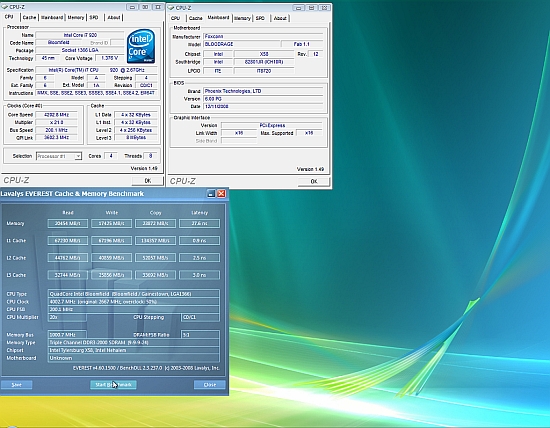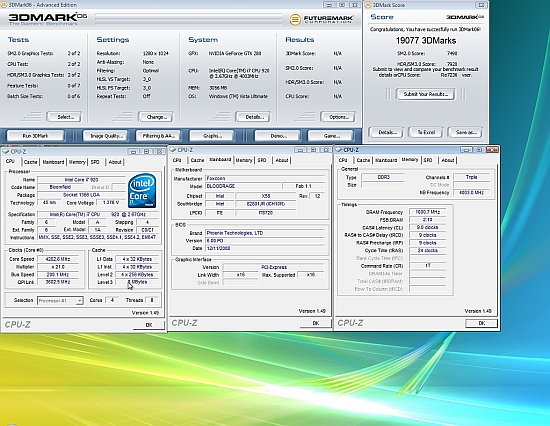Foxconn Blood Rage - If Looks Could Kill (UPDATE)
by Rajinder Gill on January 2, 2009 6:00 AM EST- Posted in
- Motherboards
Maxing out
The final challenge was to strap a cascade to the CPU and see how far we could push things with the additional overhead sub-zero temps can provide. Those of you into this sort of thing will be happy to know that we found no cold bug bootup limits on the board itself. Nehalem processors are known to average bootup limits in the region of 50-80C. Our retail i920 processors (purchased from Scan UK and Tank Guys) will boot on this board as cold as our smaller cascade will go, which is -95C (sounds lucky at this point does'nt it?).
There is one huge caveat, though: although our i920 CPU boots all the way down to the limits of the cascade, overclocking it at sub-zero temps is another matter altogether. Anything over a reference BCLK of 166MHz on the 20X multiplier refuses to boot. We added a number of shims between the evaporator and CPU to increase the temperature delta to find where this situation begins to manifest. Our saved 195 BCLK x20 multiplier BIOS profile loads fine as long as the CPU is in the positive temperature region. Anything on the negative side and we're stuck at near board defaults for voltages.
The major obstacle for us was that we were limited to using "BIOS-boot only" overclocking. As we mentioned on page 2, the AEGIS panel and the last version of SetFSB did not work properly for us. Had AEGIS panel worked, we would have been able to tinker with voltages at the OS level perhaps providing us with enough room to manipulate the BCLK reference clock to favorable levels. BIOS voltages for the CPU and VTT/Uncore were raised and lowered in BIOS to see if we could get around any kind of current limiting at negative DTS readings; unfortunately, these attempts proved unsuccessful. What we ended up with as workable voltage put us in a worse position than when we were using water-cooling at ambient temps.
It seems we have an i920 processor with an odd cold bug, or perhaps we're seeing what could be some kind of power throttling due to a built-in CPU thermal condition breach. Nehalem monitors processor Vcore at all times and can make dynamic changes on-the-fly in an attempt to rectify temperatures that fall above or below predefined DTS thresholds. Still, this is another story altogether and not something we're blaming the board for just yet. Although we are beginning to see BIOS's on other boards that offer partial workarounds to some of these conditions. A hard modification will be required to the Blood Rage to overcome some fo the current throttling at the PWM end of things, and this is an avenue we will explore. Before doing that, we're going to try out a few more processors to double-check everything and report back in the full review.
After all that effort, it was back to water-cooling the processor, and we managed to get a clean boot at 200 BCLK on the 20-21X multiplier and run 3DMark06 along with several other benchmark programs and applications.
 |
 |
We did manage to get the board to boot at 203 BCLK, but it seems our processor is too VTT hungry (at least on this current BIOS) to scale past this at voltages we'd deem being past intelligent for ambient benchmarking. The i920 series is hampered in this regard by Uncore and QPI MHz limits, although we did try lowering the multiplier/memory speed to work around this without success. Future tests will be compared against a retail Extreme i7-965 CPU to get a broader picture of motherboard capabilities.










66 Comments
View All Comments
Mr Roboto - Thursday, February 26, 2009 - link
But, but, it looks so coooool. Who really cares how well it works. I just want to show it off to people. I'm sure I can think of an excuse why it's not working if they ask me to fire it up.Everyone will think I'm cool for owning a $300+ motherboard.
kompulsive - Wednesday, January 14, 2009 - link
Epic over hype fail.cactusdog - Friday, January 9, 2009 - link
Thanks for highlighting the issues with the motherboard.An issue like this could be terrible for a consumer, especially if it is their main computer.
Consumer buys board,consumer spends several hours/days trying to get board working right. Consumer cant fix it so he researches the net for an answer for another few hours/days. Consumer learns PSU is not compatible and starts RMA process. Consumer now has no computer while he waits weeks for a replacement. Consumer buys another board because he needs a working computer while he waits for RMA.
2 months after original purchase the $300+ board is working. Board is now obsolete because there are newer better boards available.
Consumer is very annoyed.
This is why its very important for reviewers to be upfront and not make excuses for manufacturers. Thanks for doing so in this article.
kompulsive - Wednesday, January 7, 2009 - link
Overrated motherboard fail.Kougar - Monday, January 5, 2009 - link
Thanks for the early look at this book. Frankly it's not the benchmark results that are useful but reviews like these that try to cover issues and functionality. Unless there some deficiency the benchmarks are all going to be nearly the same between other similar chipset boards anyway, I find myself barely glancing at them anymore.Also I wanted to say thanks for the update. That is important info to know and I'm glad that was able to be sorted out. I wonder why so many motherboards are still having issues with very specific power supplies, seems to be several each year, year after year.
Rajinder Gill - Tuesday, January 6, 2009 - link
Hard to say Kougar. I guess standby voltages on a new platform and given that this board is very very power centric. Switch on surge and current draw may be on the brink of some of the earlier units coming out of a rest/cold boot. On a sidenote, PSU's can be equally to blame at times, revisions are sometimes made and not documented to the public until something like this happens and raises question marks.later Raja
fjs - Monday, January 5, 2009 - link
To echo the comments of an earlier poster, I would appreciate photographs in the article which demonstrate the available internal and external connectors adequately.I can see 2 SATA ports, and there are supposed to be 6. Where are the others hiding?
strikeback03 - Monday, January 5, 2009 - link
6 SATA ports are in the angled connectors at the bottom right of the board, below the IDE connector.fjs - Monday, January 5, 2009 - link
Thank you. I can see now there are 8 SATA ports. The two I noticed were the Marvell-driven ones. The ones you refer to are orientated in the plane of the board, which I did not expect.Again, to AnandTech, a plea for more connector photos in future reviews.
yyrkoon - Sunday, January 4, 2009 - link
I personally am not coming down on you, or any Anandtech staff. You guys ( and gals? ) have a hard time making your readers, and supplying companies happy with your reviews.I would suggest however that Anandtech call it like it is, or just plain refuse to to document your findings on the web UNTIL things are corrected. As it stands, Foxconn is one of several name brands I would never touch, and this would be a perfect example why. Being name brand centric is nothing close to being a 'fanboi', it is simple common sense. Buy a $300 motherboard that does not work, or does not work correctly ? Sorry, I am not seeing the logic here. People pay extra for GOOD STUFF, not garbage. Also, like said at least a couple of times already, I am NOT a paying beta tester. I get paid to beta test, not the other way around.
I also am becoming frustrated when reading these reviews. I often go out on my own any more, and research hardware elsewhere. Try explaining that to your advertisers. The above is not a threat, or someway for me to make you at anandtech feel bad; it *is* the truth.
You guys seeing, or saw whats happening over at Toms Hardware ? It is the same thing I see happening here, just not quite as ridiculous yet.